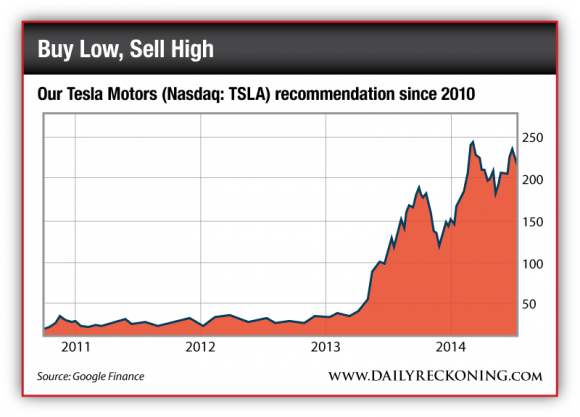The One Number Every Penny Stock Investor Overlooks
I routinely get emails from my readers that goes something like this:
“Why do you call your newsletter Penny Stock Fortunes when many stocks in your portfolio are priced at $40 and up? I was under the impression that a penny stock was to be $5 or maybe $10 and under. Apparently not, as at least one of your picks is $100. Does not compute.”
It’s a fair question.
It’s true that there are a few stocks I have in my Penny Stock Fortunes portfolio that cost more than $40 per share as of this writing.
For instance, a share of Tesla Motors (NASDAQ:TSLA) will run you over $200 at the moment. But if it’s any consolation, we didn’t buy any of those companies when they cost $40 per share or more.
In Tesla’s case, we bought it on October 20, 2010 when shares were trading at just $20.35. I’m telling readers to keep holding too.
Here’s the 1030% runup we’ve had so far:
Typically, we only have high-priced names like Tesla in our portfolio because we’re up on most of them.
But that doesn’t change the fact that most investors — maybe even you — have an unhealthy fixation on share price. And that’s a problem.
You’re programmed to obsess over share price from the first day you open your brokerage account. But too much emphasis on share price can be just as hazardous to your portfolio as listening to penny stock promoters certainly is.
Today, I want to show you how to avoid that pitfall.
You see, there’s a difference between a low price and a small company. And you may not realize it, but a company can determine its share price with a simple vote.
By changing the number of shares that a company has outstanding (a move called a split or reverse split, depending on whether the number of shares increases or decreases), the price changes too.
For example, a company could double the number of shares it has outstanding, leaving each share worth half its original value. Or a company could decrease the number of outstanding shares by half — and double the price of each share.
See, contrary to popular belief, a stock split isn’t some lucrative windfall for investors — it doesn’t change what your investment in a company is. Whether you have 100 shares of a $1 stock or one share of a $100 stock, your position is worth $100.
What companies don’t have direct control over is their total value, or what’s called their market capitalization. That’s the number you should pay attention to if you’re trying to identify a penny stock opportunity.
In other words, if you think of a company as a pie, then each individual piece of the pie is a share. A company can vote to cut each share into more pieces, but that doesn’t create more pie — just smaller pieces. The only way to truly create value for shareholders is to bake another pie.
Your position size and gain percentage determine your profits on an investment, not the share price of the stock.
For further evidence that price doesn’t tell the whole story, look at Vodafone Group. It’s a $136 billion phone carrier and one of the biggest cellphone carriers in the world. It has almost 100,000 employees.
This isn’t a small stock by any stretch. Yet you can buy one class of its shares for just $3.35.
Does that make it a penny stock? No… not in my book. On the other hand, take our current position in Standard Motor Products (NYSE:SMP).
It was a $13 stock when we bought shares — nearly four times the price of Vodafone’s most recent price. But with a market capitalization of just $790 million, SMP is a far smaller company than Vodafone — Standard’s entire value is just over one half of one percent of Vodafone’s, in fact.
Is it easier for a $3.35 stock to double to $6.70 than it was for SMP to go to $26?
No way!
Could Vodafone double from here? Maybe. But it’s a huge player in a saturated market. On the other hand, we’ve already seen a double in shares of Standard Motor Products; actually, we’re up more than 245% on our position and I’m telling my readers to hold the stock.
At last count, there were more than 250 large-cap stocks (companies worth more than $10 billion) with share prices under $10. None of them are small companies, but by only focusing on price, it’d be easy to think they were.
It’s a whole lot harder for a company worth $136 billion to double its size than it is for a $790 million car parts maker to double its business.
But aren’t higher-priced stocks more expensive for you to buy as an investor? No, not really.
Take a look at Pier 1 Imports (NYSE:PIR), a stock that I recommended in the summer of 2013. At just over $24, one share would obviously cost you more than a $5 stock would.
But you’re not buying just one share of that stock, right? If you did, your trading commissions would take a huge chunk out of any potential profit you could expect to make — even if the stock doubled or tripled.
Instead, you buy some quantity of shares. The total dollar value of all your shares in a single stock is called your position size, and it matters a whole lot more for your potential gains than share price does.
Earlier, I said that whether you have 100 shares of a $1 stock or one share of a $100 stock, it doesn’t change the fact that your position size is $100.
Either way, a 50% gain works out to a $50 profit. Your position size and gain percentage determine your profits on an investment, not the share price of the stock.
Just as importantly, your position size determines your risk — after all, a bigger position size means that a potential loss has a bigger impact on your portfolio.
Always figure out your position size independent of a stock’s share price. So if you decide that you’re comfortable putting a $1,000 position in Pier 1, for example, then you’d want to buy approximately 42 shares (42 shares times $24 per share equals a $1,008 position size).
And yes, you can buy odd numbers of shares — with almost any discount broker, commissions are exactly the same no matter how many shares you buy (with a few rare exceptions). The days of being forced to buy 100-share lots went out with the 1980s.
If a company’s size, not its share price, really determines whether it’s a true penny stock, what number should we really be focusing on?
It’s the market capitalization (better known as market cap).
Market capitalization is a pretty simple concept: It’s just the combined value of every single share of a company’s stock. It’s the “whole pie” picture of a company’s size. The only way to increase a stock’s market capitalization is to create returns for shareholders — no accounting tricks will do it.
You can find a company’s market cap at any major investing website like Google Finance or your broker’s homepage.
In general, $2.5 billion is the cutoff for what defines a small cap stock. Bear in mind that number goes up over the years for inflation, so a decade from now, $3 billion could be the definition of a small cap.
But the overall idea is the same: Small caps are small companies with exciting growth opportunities which mean the biggest potential for gains.
Historically, it’s those small caps, not low-priced stocks, that have held the keys to riches. If you’ve heard about the penny stock beginnings of companies like Apple, you’ve been misled.
Historically, it’s those small caps, not low-priced stocks, that have held the keys to riches.
Apple went public in 1980 for $22 per share. It wasn’t a penny stock then — but it was a small cap. Today, each share of Apple bought for $22 would be worth $2,632; that’s a gain of 11,866.4%.
When Microsoft went public for $21 in 1986, it was a small-cap name too — after splitting many times over the years, shareholders who bought on day one are up 34,027% as of the tech giant’s last close.
In reality, very few of the biggest gain stories of the last few decades started off with sub-$5 prices — but almost all started as small-cap stocks.
It’s normal to get fixated on a stock’s share price — it’s the first thing you see when you pull up a quote, after all. But price isn’t what matters. Small companies with explosive growth potential have should be your focus, no matter their price.
Regards,
Jonas Elmerraji
for The Daily Reckoning
P.S. Right now, I’m tracking a brand new list of small companies with incredible growth potential. And in today’s free email edition of The Daily Reckoning, I gave subscribers a code that could grant them exclusive access to these explosive names… and all the potential profits that come with them. To ensure you never miss another great opportunity like this, sign up for the FREE Daily Reckoning email edition, right here.




Comments: